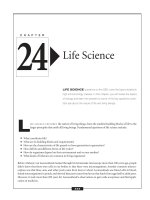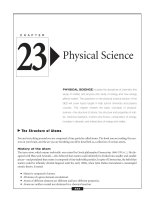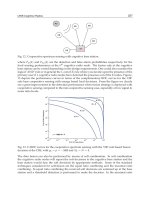About the ged writing exam 9 potx
Bạn đang xem bản rút gọn của tài liệu. Xem và tải ngay bản đầy đủ của tài liệu tại đây (105.43 KB, 6 trang )
Pretest: GED Language Arts,
Writing
Directions: In the passage below, the paragraphs are let-
tered, and the sentences are numbered. Read the passage
carefully and then answer the multiple-choice questions
that follow. Choose the best answer for each question.
To practice the timing of the exam, take 15 minutes to
complete this pretest. Record your answers on the answer
sheet provided below. Make sure you mark the answer in
the circle that corresponds to the question.
Note: On the GED, you are not permitted to write
in the test booklet. Make any notes on a separate piece
of paper.
Questions 1 through 10 refer to the following passage.
Batman
A
(1)Year after year, one of the most popular Hal-
loween costumes for children and adults alike is
Batman. (2)In fact, this superhero, was created in
1939 and known worldwide, continues to be one of
the most popular comic strip characters ever
created.
B
(3)Batman was the brainchild of comic book artist
Bob Kane. (4)Who was just 22 years old when he
was asked to create a new superhero for DC
Comics. (5)Superman was a phenomenal success,
and DC Comics wanted another hero, just as pow-
erful, to appeal to it’s readers. (6)Kane’s idea for
Batman reportedly came from Leonardo da Vinci’s
famous sketch of a man flying with bat-like wings
and the heroes in the Shadow and Zorro series who
wore masks.
C
(7)Kane’s Batman was a success that was big right
from the start. (8)The masked hero soon moved
from comic books to its own newspaper strip, and
in 1943, Batman episodes were aired on the radio.
(9)In 1966, live-action Batman shows hit the TV
screen. (10)The series was wildly popular, and the
syndicated show still airs today on channels like the
Cartoon Network.
D
(11)Batman is really Bruce Wayne a millionaire
who witnessed the murder of his parents as a child.
(12)Why was Batman so popular? (13)The answer
may lie in the background Kane gave his character.
(14)He vowed to avenge their deaths and the bring-
ing of criminals to justice. (15)He didn’t have any
supernatural powers. (16)Instead, he devotes his
life to training his body and mind to fight crime
and used his wealth to develop high-tech crime-
fighting tools and weapons, like his famous Bat-
mobile. (17)Thus, Kane created a superhero who is
just as human as the rest of us. (18)In Batman,
Kane gave us an image of our own superhero
potential.
1. Sentence 2: In fact, this s
uperhero, was created in
1939 and kno
wn wo
rldwide, continues to be one
of the most popular comic strip characters ever
created.
Which is the best way to write the underlined
portion of this sentence? If the original is the
best way, choose option a.
a. this superhero, was created in 1939 and
known worldwide, continues
b. this superhero, having been created in 1939
and known worldwide, continues
c. this superhero, created in 1939 and known
worldwide, continues
d. this superhero, was created in 1939 and
known worldwide, and continuing
e. this superhero, who was created in 1939 and
being known worldwide, continues
– THE GED LANGUAGE ARTS, WRITING EXAM–
30
1. abcde
2. abcde
3. abcde
4. abcde
5. abcde
6. abcde
7. abcde
8. abcde
9. abcde
10. abcde
ANSWER SHEET
2. Sentences 3 and 4: Batman was the brainchild of
comic book artist B
ob Kane. Who was just 22
years old when he was asked to create a new
superhero for DC Comics.
Which is the best way to write the underlined
portion of these sentences? If the original is the
best way, choose option a.
a. Bob Kane. Who was
b. Bob Kane; who was
c. Bob Kane. Kane was
d. Bob Kane, who was
e. Bob Kane, while he was
3. Sentence 5: Superman was a phenomenal suc-
cess, and DC Comics wanted another hero, just
as powerful, to appeal to it’s readers.
Which correction should be made to
sentence 5?
a. Change he
ro to Hero.
b. Change it
’s to its.
c. Replace Superman was with Superman is.
d. Insert a comma after C
omics.
e. No correction is necessary.
4. Sentence 6: Kane’s idea for Batman reportedly
came from Leonardo da Vinci’s famous sketch of
a man flying with bat-like wings and the heroes
in the Shadow and Zorro series who wore masks.
Which revision should be made to sentence 6?
a. Change man fl
ying to flying man.
b. Replace bat-lik
e wings with having wings like
a bat.
c. Start a new sentence after wings.
d. Change reportedly came from to was reported
c
oming from.
e. Move who wore masks to follow the heroes.
5. Sentence 7: Kane’s Batman was a s
uccess that was
big right from the start.
Which is the best way to write the underlined
portion of sentence 7? If the original is the best
way, choose option a.
a. was a success that was big
b. was a big success
c. was successful in a big way
d. was successfully big
e. is a successful thing
6. Sentence 11: Batman is really Bruce Wayne a mil-
lionaire who witnessed the murder of his parents
as a child.
Which correction should be made to
sentence 11?
a. Insert a comma after W
ayne.
b. Replace w
ho with that.
c. Change wit
nessed to sa
w.
d. Replace as a c
hild with d
uring his childhood.
e. No correction is necessary.
7. Sentence 11: Batman is really Bruce Wayne a
millionaire who witnessed the murder of his
parents as a child.
Which revision should be made to the place-
ment of sentence 11?
a. Move sentence 11 to follow sentence 7.
b. Move sentence 11 to the end of paragraph C.
c. Move sentence 11 to follow sentence 12.
d. Move sentence 11 to follow sentence 13.
e. Move sentence 11 to follow sentence 14.
8. Sentence 14: He vowed to avenge their deaths
and the b
ringing of criminals to justice.
Which is the best way to write the underlined
portion of this sentence? If the original is the
best way, choose option a.
a. and the bringing of criminals to justice
b. and brought criminals to justice
c. and will bring criminals to justice
d. and bring criminals to justice
e. and that he would bring criminals to justice
9. Sentence 16: Instead, he devotes his life to train-
ing his body and mind to fight crime and used
his wealth to develop high-tech crime-fighting
tools and weapons, like his famous Batmobile.
Which correction should be made to
sentence 16?
a. Change d
evotes to devoted.
b. Replace t
o fight with fighting.
c. Change hig
h-tech to high, tech.
d. Insert a comma after body.
e. No correction is necessary.
– THE GED LANGUAGE ARTS, WRITING EXAM–
31
10. Sentence 18: In Batman, Kane gave us an image
of our own superhero potential.
The most effective revision of sentence 18
would begin with which group of words?
a. However, Batman was someone in whom
Kane
b. Therefore, in Batman, we are given
c. More importantly, in Batman, Kane gives us
d. On the other hand, in Batman, we see
e. Thankfully, it is in Batman that we have
Pretest Answers and Explanations
1. c. The nonessential information in this sentence is
best set off by commas, and choice c is the only
version that is grammatically correct. Choice a is
incorrect because the information set off by
commas is incomplete (was should be deleted,
or who should be inserted before was). Choice b
is incorrect because the verb phrase having been
created is incorrect; the correct helping verb
would be had, not having, and the clause would
require which before had. Choice d is incorrect
for the same reason as a, and the verb continuing
should be in the past tense. Choice e is incorrect
because the verb being should be either the pres-
ent or past tense, not a present participle.
2. d. Sentence 4 is best attached to sentence 3 as a
nonessential who clause, thus providing extra
information regarding the creation of Batman.
Choice a is incorrect because sentence 4 is a sen-
tence fragment. Choice b is incorrect because a
semicolon can only be used between two com-
plete sentences (independent clauses), and sen-
tence 4 is an incomplete sentence. Choice c is
correct, but it unnecessarily repeats Kane;com-
bining the sentences with a who clause elimi-
nates the repetition. Choice e is incorrect
because it is wordy and awkward.
3. b. It’s is the contraction of it is; the sentence needs
the possessive form, its. Choice a is incorrect
because hero is not a specific noun and should
not be capitalized. Choice c is incorrect because
the verb was needs to remain in the past tense.
Choice d is incorrect because commas should
not separate subjects and verbs unless a com-
plete phrase or clause is inserted. Choice e is
incorrect because it’s needs to be corrected.
4. e.
The modifier who wore masks should be moved
after heroes to be as close as possible to the noun
it modifies. Choice a is incorrect because flying
should be as close as possible to the preposi-
tional phrase with bat-like wings; reversing man
and flying would indicate that the man was a fly-
ing man, not a man who flew with bat-like
wings. Choice b is incorrect because bat-like
wings is a more concise modifier than having
wings like a bat; also, the verb having cannot fol-
low flying with. Choice c is incorrect because the
new sentence beginning with and would be a
fragment (incomplete sentence). In choice D,
the verb phrase was reported coming is incorrect.
5. b. This is the most concise and correct way to con-
vey this idea. Choice a is unnecessarily wordy.
Choice c is too informal (in a big way is slang).
Choice d is awkward and states that the size was
a success, not that the comic strip was a success.
Choice e is incorrect because thing is too gen-
eral; a more precise noun should be used.
6. a. The information after Wayne is a nonessential
descriptive clause that needs to be set off by a
comma. Choice b is incorrect because who
should be used when referring to people; that
should be used to refer to things. Choice c is
incorrect because witnessed is a more precise
word than saw. Choice d is incorrect because it
is more wordy and also suggests a longer time
frame, as if the murder occurred over time.
Choice e is incorrect because the comma after
Wayne is necessary.
– THE GED LANGUAGE ARTS, WRITING EXAM–
32
7. d. Sentence 11 is the first sentence describing Bat-
man’s background, so the most logical and
effective place for this information is after sen-
tence 13: The answer may lie in the background
Kane gave his character. Choice a is incorrect
because paragraph C describes Batman’s suc-
cess, not his background. Choice b is incorrect
for the same reason. Choice c is incorrect
because the sentence doesn’t directly answer the
question asked in sentence 12; sentence 13 needs
to state the answer (Batman’s background) first.
Choice e is incorrect because we need to know
that Batman’s parents were murdered before we
learn that he vowed to avenge their deaths; we
would not know whose murder Batman was
avenging.
8. d. This choice uses parallel structure and is correct
and concise. Choice a is incorrect because to
requires the verbs avenge and bring to be in their
infinitive forms. Choice b is incorrect for the
same reason; brought is in the past tense, not the
infinitive form. Likewise, choice c uses the
future tense (will bring), so it is incorrect.
Choice e is grammatically correct, but it is
wordy and less effective than the parallel struc-
ture in choice d.
9. a. The tenses are inconsistent (present tense
devotes and past tense used). The other sentences
about Batman’s background are in the past
tense, so devotes should be changed to the
past tense, devoted. Choice b is incorrect because
to is necessary to show the relationship between
mind and fight; a gerund (fighting) would not
make sense here. Choice c is incorrect because
high and tech work together to create one modi-
fier, so the hyphen between them is necessary.
Choice d is incorrect because there are only two
items in the list (body and mind), so there
should not be a comma between them. Choice e
is incorrect because the inconsistent verb tense
needs to be corrected.
10. c. The most effective transitional phrase to begin
this sentence is more importantly. The idea
expressed in this sentence—that Batman gives
us an image of our own superhero potential—is
the most powerful explanation for why so many
people were drawn to the Batman character.
Choice a is incorrect because idea in sentence 18
does not contrast with the idea in sentence 17.
While choice b is logical (the idea in sentence 18
is an “effect” of the idea in sentence 17), choice c
is more appropriate in the context. Choice d is
incorrect because sentence 18 does not contrast
the idea in sentence 17. Choice e is incorrect
because it is wordy, and the transitional word
thankfully seems out of place in both style and
context.
Pretest Assessment
How did you do on the pretest? If you answered seven or
more questions correctly, you have earned the equivalent
of a passing score on the first part of the GED Writing
Test. But that doesn’t mean you should skip Chapter 5.
This pretest is not designed to give you an exact measure
of how you would do on the GED. Rather, it is designed
to help you determine where to focus your study efforts.
Remember, this pretest does not cover all of the material
that may be included on the GED and does not include
an essay exam.
– THE GED LANGUAGE ARTS, WRITING EXAM–
33
What to Expect on the Language Arts, Writing Exam
As you know, the Language Arts, Writing Exam has two parts. Part I consists of 50 multiple-choice questions that
measure your knowledge in four key writing areas:
■
Sentence structure—30%
■
Usage—30%
■
Mechanics—25%
■
Organization—15%
You will have 75 minutes to complete this part of the test. Each question will have five answer choices; only one
will be correct.
Because there’s a lot more to writing an effective essay than good grammar or logical organization, and because
effective writing is essential if you are to succeed in college or in the workplace, the GED writing test also includes an
essay section. Part II consists of one essay topic. You will have 45 minutes to write an essay in response to that prompt.
A lot of people are intimidated by essay exams. After all, you are being asked to write well under pressure, and if
you don’t pass the essay exam, you don’t pass the Language Arts, Writing Test. But there is some good news about the
GED writing exam. For one thing, the essay doesn’t have to be long. In fact, because you have only 45 minutes, you
35
CHAPTER
5
About the GED
Language Arts,
Writing Exam
TO PREPARE effectively for the Language Arts, Writing Exam, you
need to know exactly what the test is like. This chapter explains the
structure of the exam, including the types of questions and passages
you will see on the test.









